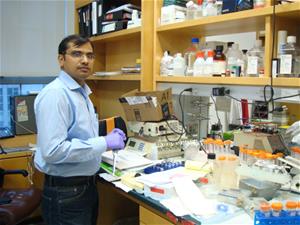Niraj Lodhi
Sigma Xi member Niraj Lodhi is a postdoctoral associate at Weill Cornell Medical College in New York. He has studied a protein to determine its function and role in controlling cancer cell growth and hopes to develop an inhibitor to eliminate cancer cells.

Please explain your research.
After completing my PhD in plant molecular biology from the National Botanical Research Institute in Lucknow, India, I started my research work on cancer. At the Fox Chase Cancer Center in Philadelphia, I studied the role and function of poly(ADP-ribose)polymerase-1 (PARP-1) in mitosis. PARP-1 is a protein that adds poly(ADP)ribose residues to nuclear proteins by utilizing the coenzyme NAD+ and regulates DNA damage repair, chromatin remodeling, and transcription. This function of PARP-1 is called poly(ADP-ribosly)ation. In an earlier study, we found that during mitosis PARP-1 remains associated with chromatin, a highly condensed complex that allows DNA to fit inside a nucleus. My research work reveals PARP-1 acts as an epigenetic factor that binds to chromatin during mitosis and memorizes genes for transcription activation after mitosis. [Transcription is the first step of gene expression.] PARP-1 bookmarks the specific genes in chromatin during mitosis, and maintains the precise inheritance of gene expression in daughter cells. Upon completion of mitosis, PARP-1 and other proteins loosen the chromatin and re-initiate the transcription of PARP-1-dependent genes responsible for cell–cell communication, cell adhesion, and cell maintenance. We called them cell identity genes.
PARP-1 also bookmarks proto-oncogenes and tumor suppressor genes throughout the genome during mitosis. A proto-oncogene is a normal gene that becomes an oncogene due to mutations or abnormally increased expression. Oncogenes have the potential to cause cancer by transforming a normal cell into a cancer cell. Tumor suppressor genes act opposite of oncogenes. Mis-regulated expression of proto-oncogenes and tumor suppressor genes in different cancer cells can be associated with PARP-1 bookmarking. Therefore, this study can be used to control over-expression of proto-oncogenes to prevent these genes from becoming oncogenes or to design specific PARP-1 inhibitors. This work was published in 2014 in Nucleic Acids Research, Volume 42, Number 11.
All presently available PARP-1 inhibitors function as competitive inhibitors to NAD+. Because NAD+ is involved in most metabolic pathways, use of these inhibitors affect physiological activities of cells. Based on our research, I am working to develop a specific inhibitor of PARP-1, independent of NAD+. We tested this inhibitor on a human prostate cancer cell line and mouse model and the results are very exciting and promising. For further study, we collaborated with another group to conduct clinical trials.
 Recently, I moved to the Weill Cornell Medical College in New York and started work on the role of DNA methylation on non-genetic inheritance of behavior, specifically anxiety, from one generation to the next. Our lab identified the differential methylated regions (DMRs) in the brain, specially the hippocampus, and I am focusing on three dimensional interactions of DMRs with genomes and how they affect gene expression from generation to generation.
Recently, I moved to the Weill Cornell Medical College in New York and started work on the role of DNA methylation on non-genetic inheritance of behavior, specifically anxiety, from one generation to the next. Our lab identified the differential methylated regions (DMRs) in the brain, specially the hippocampus, and I am focusing on three dimensional interactions of DMRs with genomes and how they affect gene expression from generation to generation.
What do you hope to accomplish with the PARP-1 inhibitor?
Recent research shows PARP-1 inhibitors control the growth of breast cancer cells, however after some generations the cells become resistant to inhibitors. The exact mechanism is not known other than PARP-1’s role in DNA damage repair. My plan is to continue to explore PARP-1’s epigenetic functions and utilize all recent research information to develop a specific inhibitor that can effectively overcome resistance from cancer cells and eliminate them.
What do you enjoy about being a Sigma Xi member?
Since I joined Sigma Xi in 2012, I took advantage of all benefits of membership. The best benefit for me is to get scientific news from all possible sources including email, social media, and the Sigma Xi online community.
The most important thing Sigma Xi provides is the views of fellow scientists for career development. I strongly support Sigma Xi membership to develop my career and I nominated one of my colleagues who is benefiting from membership.
Other members may contact me at lodhiniraj@gmail.com or on Twitter at @nirajlodhi.